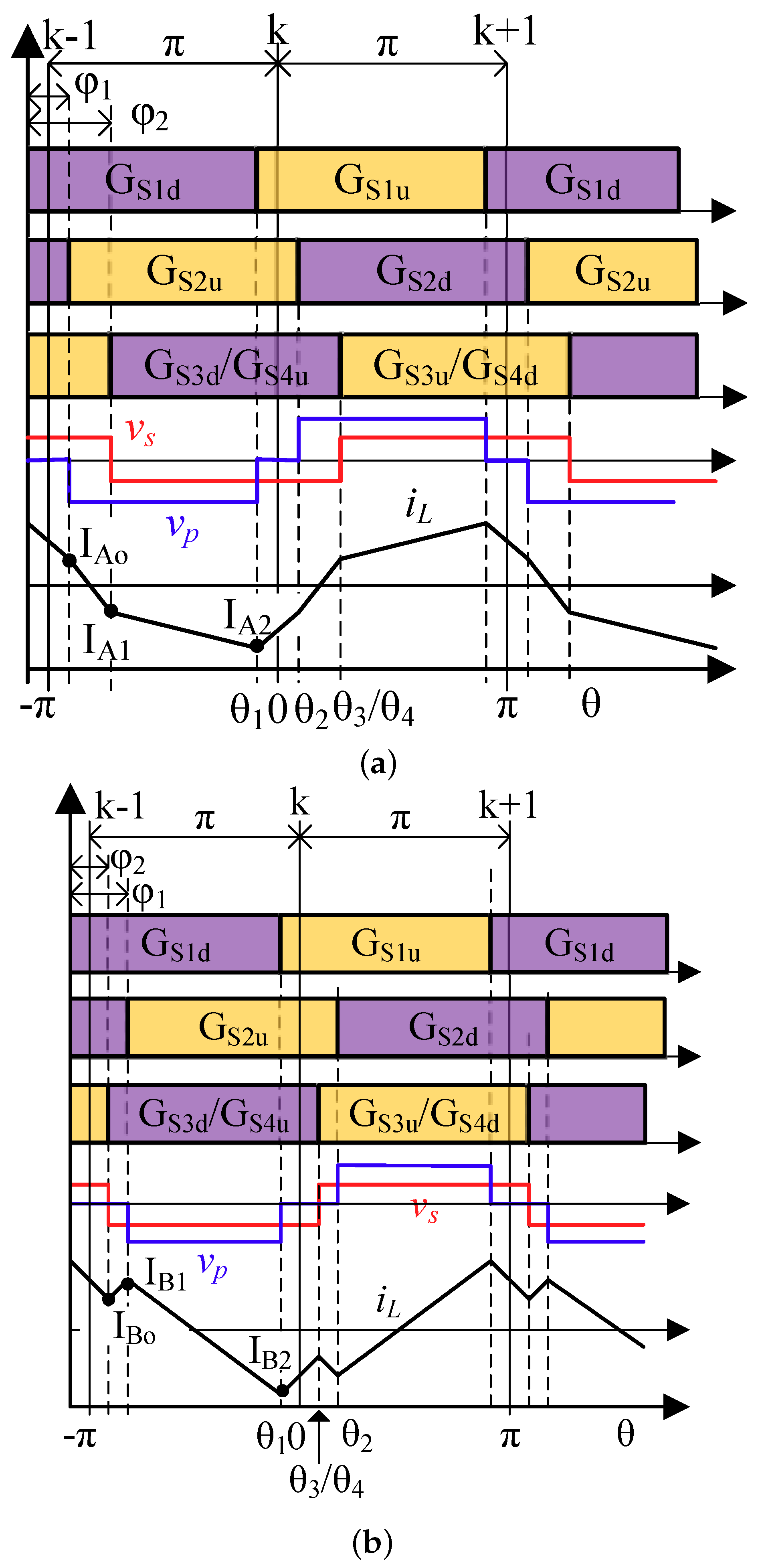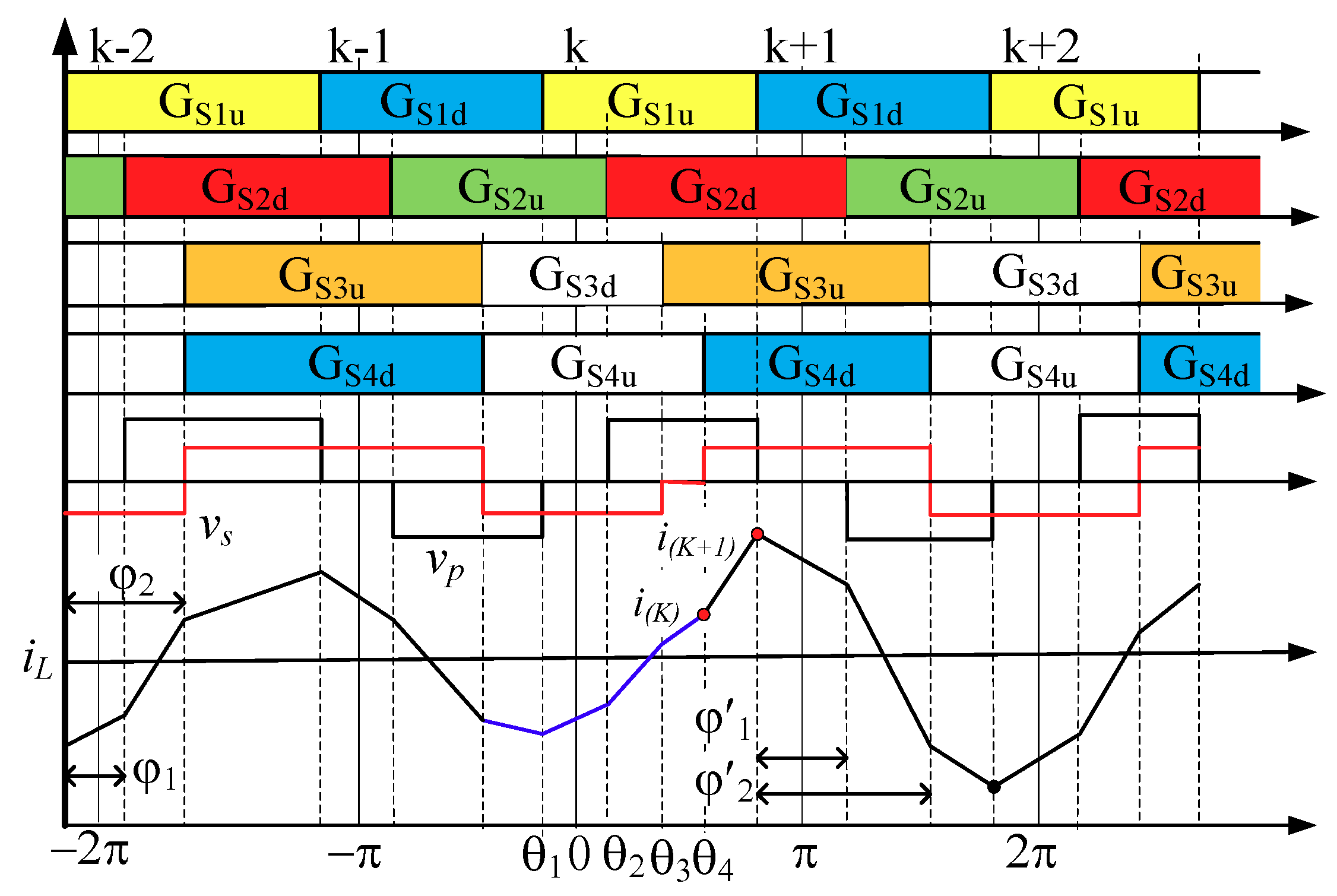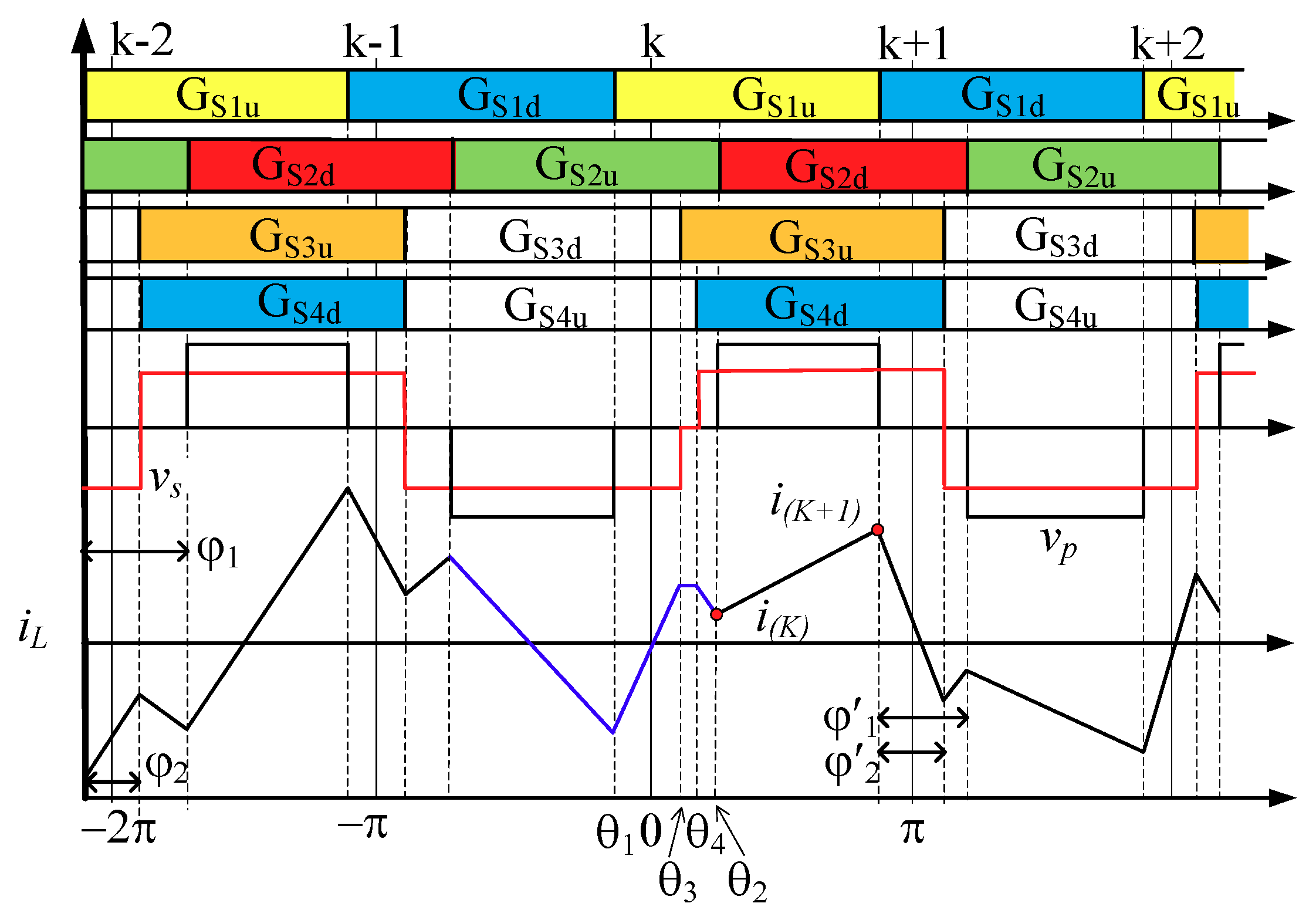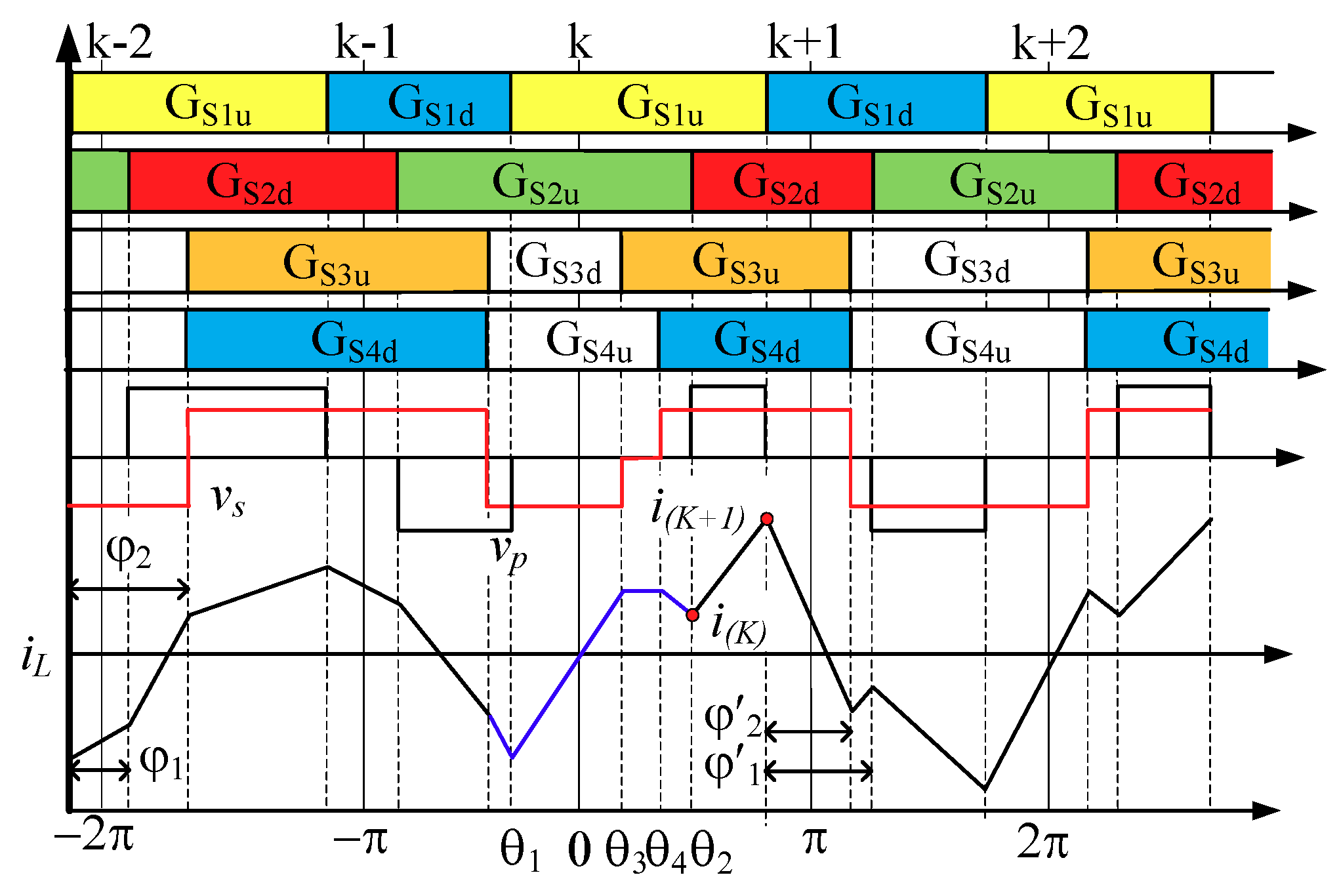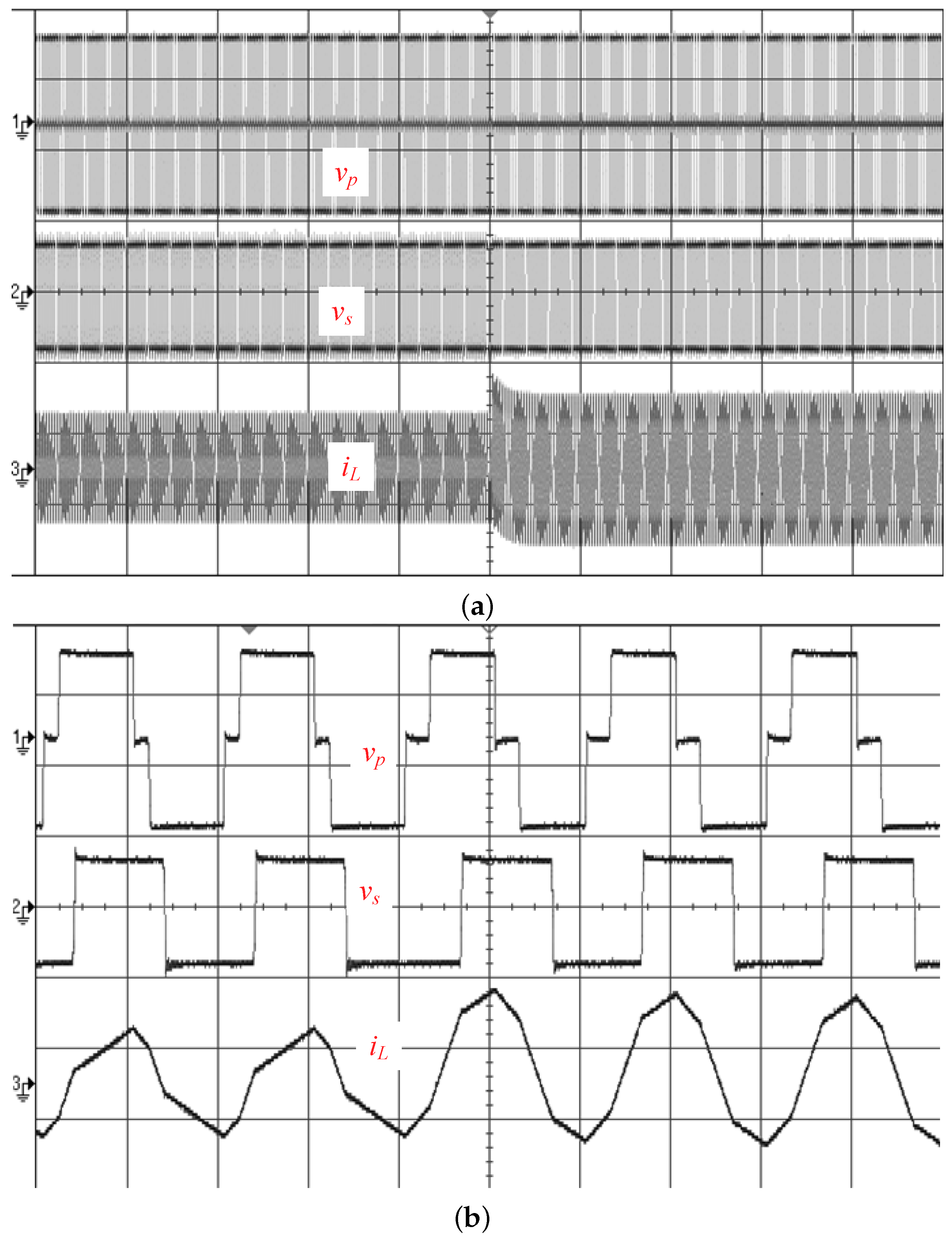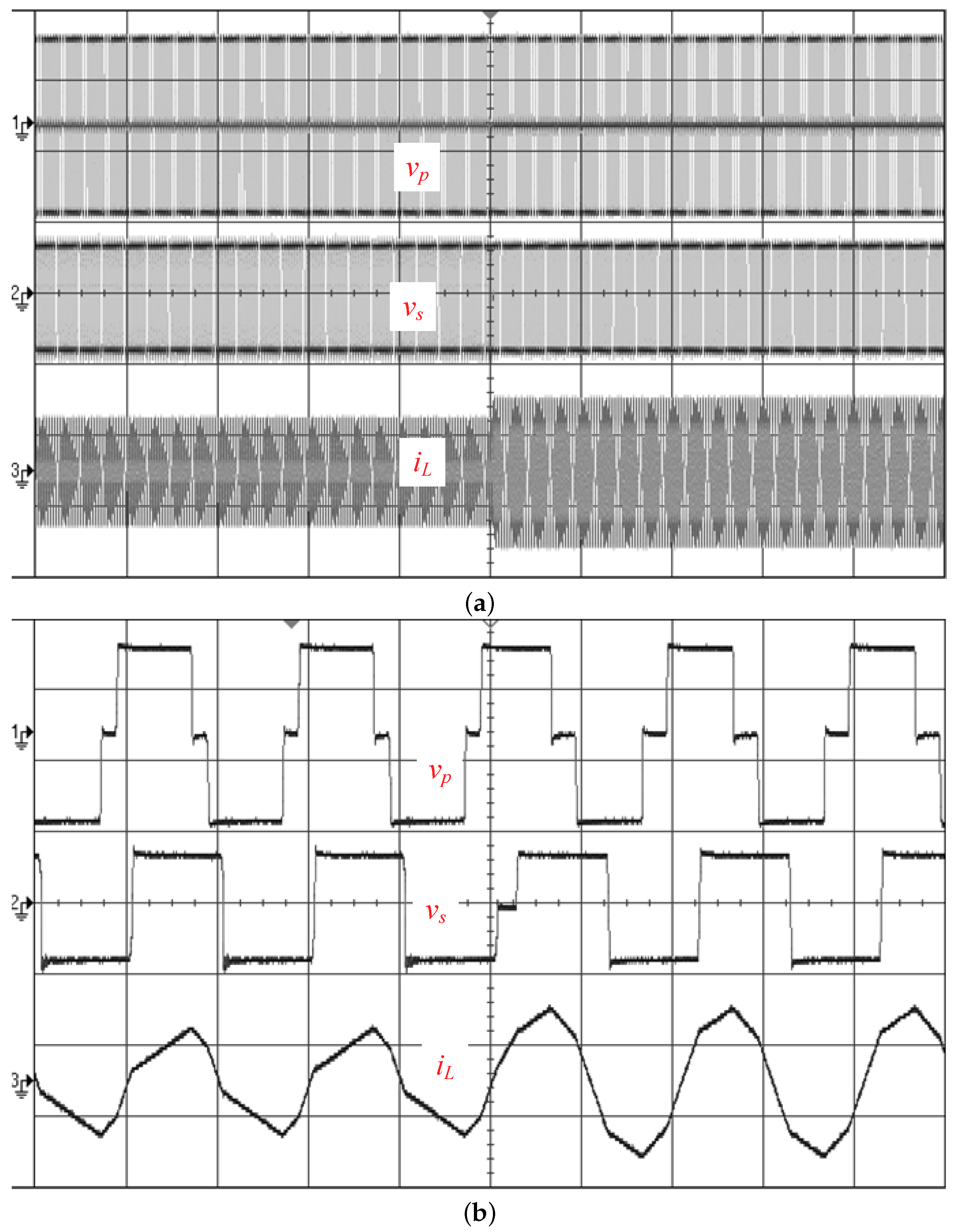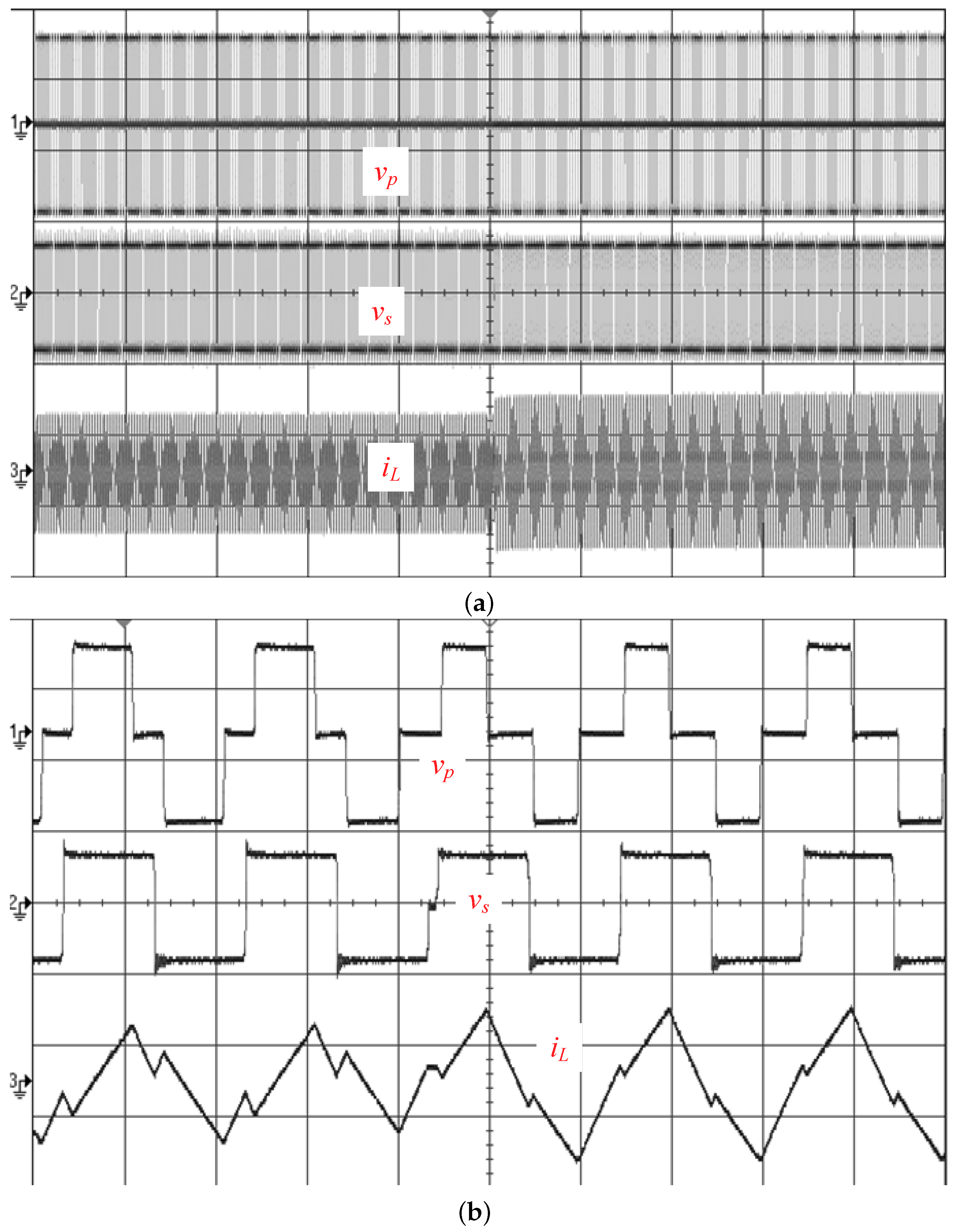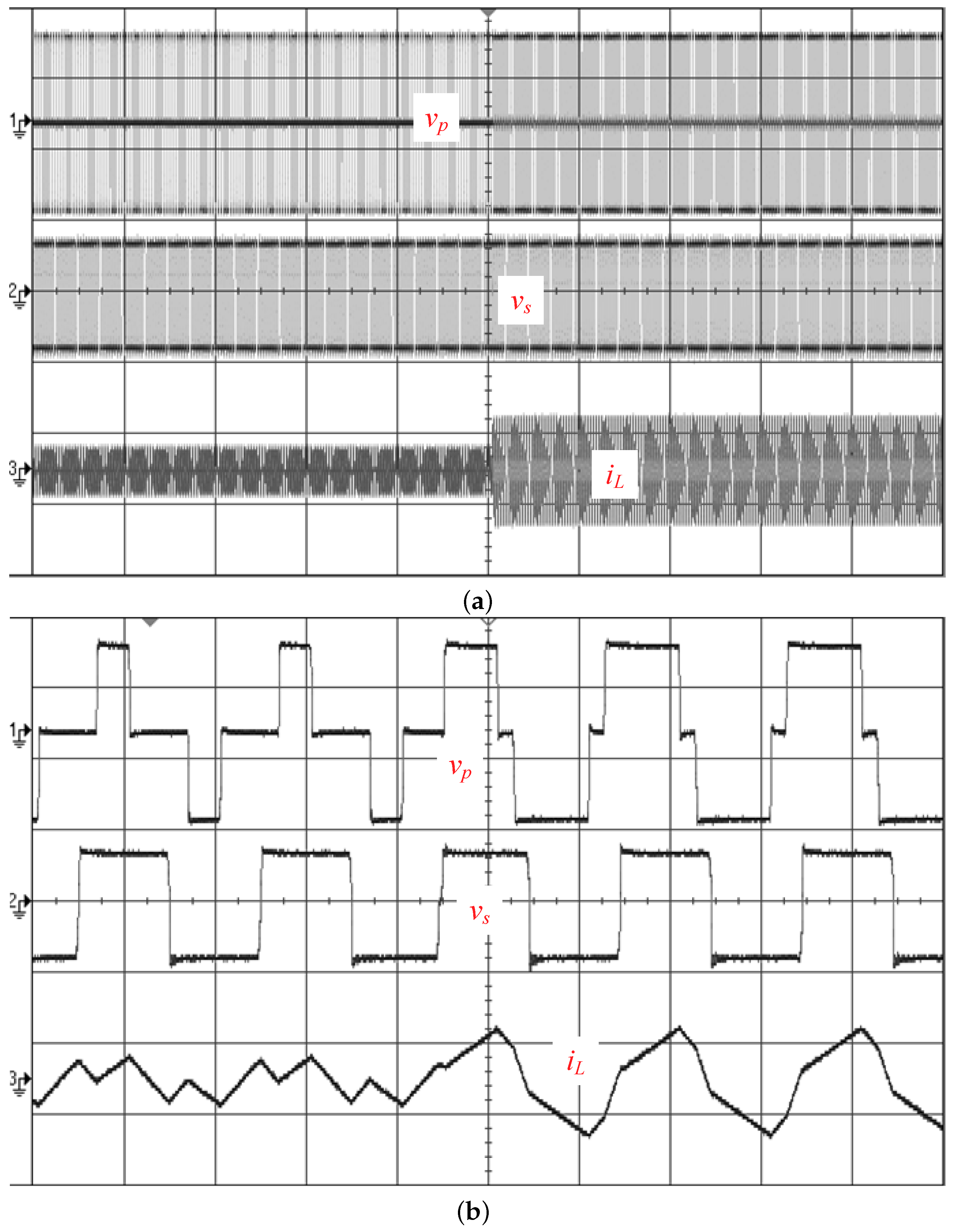1. Introduction
In recent decades, with the increasing concern in environment issue and energy crisis, the power conversion systems (PCSs) have been using widely in renewable generation facilities. The dual-active-bridge (DAB) converter seems to be a preferred choice of PCSs in various bidirectional DC/DC applications, such as energy storage systems, electric vehicles (EV) and solid state transformers, because of its high power density, low cost and zero-voltage-switching (ZVS) features [
1,
2,
3,
4,
5,
6,
7,
8,
9,
10,
11,
12,
13,
14].
Interfacing two different DC sources, the DAB converter is a kind of bidirectional DC–DC converter, which consists of two full bridges linked by a high-frequency (HF) transformer with the turn ratio of
, whose circuit layout is shown in
Figure 1. Including the leakage inductance of the transformer, the inductor
is connected on the primary side as the main energy transfer device. The resistor
, which normally is small enough to be neglected in steady-state analysis, is an equivalent resistance of
and the total winding resistance of HF transformer. The eight active switches can be controlled by their gating signals with 50% duty cycle and fixed switching frequency. The voltage gain of DAB converter is defined as
, where
is the input voltage and
is the output voltage.
and
are two HF voltages generated on the primary side and the secondary side, respectively. The power is manipulated by controlling the phase-shift angles among each switch arms.
Depending on the number of varying phase-shifts, there are several control schemes for a DAB converter, which are single-phase-shift (SPS) control, extended-phase-shift control (EPS), dual-phase-shift (DPS) control and triple-phase-shift (TPS) control. The SPS control is the simplest control strategy that is easy to implement. However, it has many disadvantages such as high circulating power and loss of ZVS if the converter gain is away from unity [
1,
2]. In addition, the TPS control has three independent phase-shifts to be controlled, which makes it costly and more complex in real implementation [
3,
4]. In contrast, EPS control and DPS control are compromised ones with both enough flexibility and easy implementation [
5,
6,
7,
8,
9,
10,
11,
12,
13,
14]. To make a step load change in a DAB converter, one or more phase-shift angles should be adjusted accordingly. The detailed procedure to adjust those phase-shift angles have direct influence on the transient responses. Improper transient control may cause temporal overcurrent and DC offset in inductor current which can arise extra losses and saturation in magnetic components. Therefore, it is necessary to propose some methods to eliminate DC offset and minimize the load transient period.
Inserting a capacitor before the transformer is an easy way to block DC bias in the HF transformer current with the increase in the cost and the size of the circuit. Current oscillation might be induced due to change of stored energy in the capacitor at the step-change of load. An effective solution by means of a special magnetic sensor and active compensator is presented in [
15], which is quite costly and complicated regardless of the excellent performance. Based on SPS control, a transient control named asymmetric-double-side modulation proposed in [
16] distributes the required phase-shift adjustment to both two bridges according to an optimized ratio to depress the DC bias current in the transition process. The same technique is then extended to EPS control in [
17,
18]. However, the obtained results in [
17] can not deal with the operation when the converter gain is close to unity. Another solution under SPS control in [
19] manipulates the gating signals of two switch arms in the same bridge with different phase-shifts during the transient process. The method was applied in a three-phase DAB converter too [
20]. Although the calculation of this method is easy and is independent on the converter gain, it can be proved that a single current pulse can be induced for specified load transient conditions. In [
21], a novel approach to keep transient voltage–time balance is to introduce a small zero-voltage duration in one of the two HF voltages. It is capable of eliminating DC bias in both inductor current and magnetizing current of the transformer. Generally, it is seen that most of the reported solutions are limited in the scenario of SPS control in a steady state. However, two or more phase-shifts are needed for power manipulation in applications with wide variation in converter gain. Thus, to explore new transient control with multiple phase-shifts will be meaningful. In this work, a load transient modulation for EPS control will be proposed for depressing DC bias current in the load-changing process, which stems from the approach in [
21]. The proposed transient control will be applied to different transition cases between the two steady-state EPS modes. It will be shown that it is able to not only reduce transient period, but also depress the DC bias effectively.
The paper is organized as follows. In
Section 2, the proposed transient control method will be analyzed in detail for each transition case. The values of all gating signal angles would be given before, during and after the transition process. The theoretical analysis is then verified by experimental tests on a lab prototype converter in
Section 3. The final conclusion is presented in
Section 4.
2. The Proposed Transient Control Method
Under the EPS control scheme, there are two phase shift angles to be used:
—the phase delay between the turn-on moment of
and that of
;
—the phase delay between the turn-on moment of
and that of
. While working under EPS, the converter may have two different steady-state modes according to the different relationship of
shown in
Figure 2. Mode A is defined with
and mode B is defined with
.
2.1. Reference Points and Definition of Switching Angles
By referring to the fixed reference point, are defined as the switching angles where , , , are turned on, respectively.
If the original mode is mode A, the reference points are defined in the mid of
and the interval between each of them is
. Thus, the switching angles in mode A are expressed as follows:
If the original mode is mode B, the reference points are defined in the mid of
. Thus, the switching angles in mode B can be expressed as follows:
It is known that in each time interval the change of inductor current is proportional to the voltage difference across it:
. Therefore, the instantaneous inductor currents at switching moments in mode A and B can be found as:
When the load level is changed abruptly, there are four condition of DAB converter in EPS control to be dealt with as shown in
Table 1.
2.2. Load Transient Control within Mode A
As shown in
Figure 3, a step load transition happened around the
reference point. In other words, the switching behaviour referring to
reference point is the original steady state with phase angles
, while the switching behaviour referring to (k+1)
th reference point is the destination steady state with phase angles
. The phase angles referring to the
reference point should be selected properly to complete the transition process as fast as possible.
With the unknown
, two important instant currents are calculated then:
where
is the instant current at the last switching point of
reference point, and
is the first current at the first switching point of
reference point.
To keep voltage–time balance, the average inductor current should be zero while the inductor current enter into the new steady state at once, which indicates:
Therefore, the following conditions can be obtained by substituting Equations (4), (5), (
9) and (10) into (
11):
It is seen that
is set to zero during the interval
. As shown in Equation (
12), the phase shift angles
and
during transitions are free to be chosen. However, they should also satisfy the requirement that
lets the converter work in mode A.
2.3. Load Transient Control within Mode B
In this condition, the DAB converter is working in mode B from beginning to end, and the reference points are defined in the mid of
. As is shown in
Figure 4, the transition is done at the
reference point and the converter is expected in the destination steady state at the
reference point. The instant currents after the intermediate adjustment are calculated as:
To meet such an expectation, the followed equation should be satisfied:
Combining Equations (7), (8), (
13), (14) and (
15), the following switching angles referring to the
reference point can be calculated to achieve a fast transition within mode B:
It is seen that
is set to zero during the interval
. Equation (
16) reveals that
and
can be selected flexibly. However, they should also satisfy
to let the converter work in mode B.
2.4. Load Transient Control from Mode A to Mode B
In this condition, as shown in
Figure 5, the phase shift angles are changed from mode A to mode B by means of the intermediate adjustment around the
reference point. Different from the previous cases, the definition of switching angles are changed since that the original mode is not the same as the destination one. The instant currents after the intermediate adjustment are calculated as:
To minimize the transient period, the same requirement shown in Equation (
15) should be met. Combining Equations (7), (8), (
17), (18) and (
15), the intermediate switching angles for transition from mode A to mode B are given as:
It is seen that is set to zero during the interval . From the results, it can be found that switching angels and can be determined flexibly. Meanwhile, the condition of mode boundary should be met too: .
2.5. Load Transient Control from Mode B to Mode A
In this condition shown in
Figure 6, the original state is mode B while the final state is mode A. Therefore, the instant currents after the
reference point can be calculated starting from mode B:
As the switching angles are redefined in mode A at the
reference point, the requirement for the expected fast transition is the same as (
11). Substituting Equations (4), (5), (20), (21) into Equation (
11), switching angles during transient process referring to the
reference point for the transition from mode B to mode A are:
In this case, and can be chosen flexibly, but is subject to and .
3. Validation by Experimental Results
In order to validate the theoretical results, load transition cases using the proposed control method were tested on a lab prototype DAB converter.
Table 2 shows the specifications of the converter used in the experiments. The circuit adopts four power MOSFETs (STP40NF20, 200 V, 40 A, 0.038
) on the primary side and the other four power MOSFETs (IPP200N15N3G, 150 V, 50 A, 0.020
) on the secondary side as the switches. The input terminals were connected to a DC power supply, while the output terminals were connected to a DC electronic load. The inductor is made of a toroidal CM400125 MPP core with litz wire winding. The proposed transient control is implemented in a TI-F2812 DSP development board (Texas Instruments, Dallas, USA) and the flowchart is shown in
Figure 7. The converter power level is monitored continuously. If no change is to be made to the power, the current
are used to generate
∼
. If a new power command is received and confirmed, the destination will be calculated based on some preset algorithm optimized for better efficiency, which is out of scope of the current work. Then,
for the next reference point will be updated by
by using one of Equations (
12), (
16), (
19), (
22).
The detailed parameters of phase-shift angles of each mode in experiment are shown in
Table 3,
Table 4,
Table 5 and
Table 6. For each tested load-change condition, a condensed view of the transition is given firstly with a time scale of 300
s/div while the details are shown later with a time scale of 5
s/div. In each plot, captured waveforms of
,
(100 V/div) and
(2 A/div) are shown from top to bottom.
As an example for comparison, the first case tested (
Figure 8) is a transition within mode A by directly changing the phase-shifts. The phase-shift angles
,
are changed from
,
to
,
. The inductor peak current is expected to rise from 1.56 A to 2.13 A. However, an abnormal peak current 2.95 A results in a transient process and it takes about 20 HF cycles to be absorbed. In the duration of transient process, a temporal DC bias current decays from about 0.69 A until zero.
The same transition is then repeated with proposed transient control in
Figure 9. According to (
12),
are calculated as
and
during the transient process. While satisfying (
12), the switch angles
and
are selected as
and
during transient for the purpose of convenience. In addition, the final values of
∼
are
,
,
and
. The transient process now can be completed almost instantly as shown in
Figure 9. It is seen that there is no noticeable overshoot current.
For the load transition from mode B to mode B in
Figure 10, the phase-shift
,
are changed from
,
to
,
. After the transient modulation, the switching angles
,
,
and
are changed from
,
,
,
to
,
,
and
, respectively. During the transient process,
are calculated
,
directly according to (
16). In addition, the transient
and
are selected as
and
respectively.
In the condition of transition from mode A to mode B in
Figure 11, the phase-shift
,
are changed from
,
to
,
. The initial angles
,
,
and
are
,
,
,
and the final angles should be
,
,
and
, respectively. At the
reference point,
,
are determined to be
and
based on (
19). Under the constraint given in (
19), the switching angles
and
are selected as
and
, respectively, for the purpose of convenience.
In
Figure 12, the condition of transition from mode B to mode A is presented, in which the phase-shift
,
are changed from
,
to
,
. The initial angles
,
,
and
are
,
,
,
and the final angles should be
,
,
and
, respectively. At the
reference point,
,
are determined to be
and
based on (
22). Under the constrain given in (
22), the switch angles
and
are selected as
and
for the purpose of convenience.

